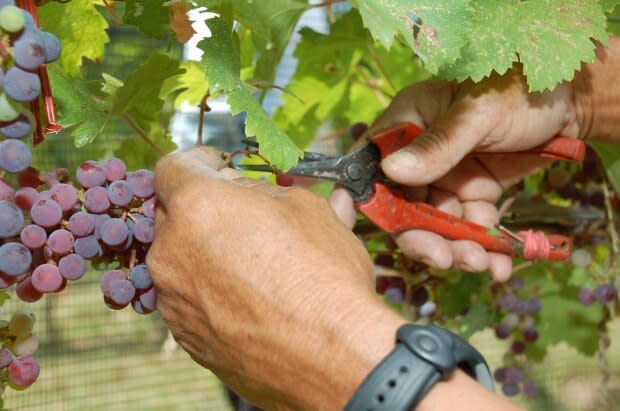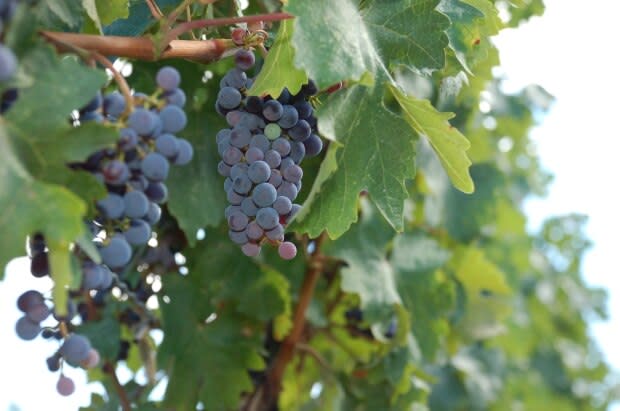Why winemakers in Ontario are excited to harvest their grapes this fall: Andrew Coppolino
It hasn't been a very good year for many people, but Niagara winemakers say it looks like it's going to be a great year for them.
That's because many are anticipating a high quality of grapes in their vineyards when they start fall harvest.
Jakub Lipinski, a proprietor and head of operations at Big Head Wines in Niagara-on-the-Lake, anticipates making some excellent wine — if current conditions hold.
"The most important time is right now," Lipinski says. "It's beautiful, and the nights are cool. It's actually looking to be a perfect vintage."
Rain is an element winemakers don't want at this point. When it's needed, grape growers can irrigate, but humidity and rain at the wrong moment — September and October — can cause damage when grapes are most vulnerable because their skin is at its thinnest.
Grapes change colour around the end of August — what's known as "veraison," especially with this summer's heat — and Lipinski calls that the tipping point where they start looking at the vineyard with an eye to picking.
Gabe Demarco, oenologist and viticulturist at Cave Spring Vineyard in Jordan, Ont., calls conditions "exceptional." Although there is still a month or two to go, he judges that his Pinot Noir should be top notch.
"We had good heat units and now it's a cool extended fall where we can hang the fruit and pick it when we want to, rather than being told to by Mother Nature," Demarco said.
He adds that early-ripening varieties are close to being ready, while late-ripening varieties are "looking really nice."
Hot, dry weather helped
At Southbrook Vineyards in Niagara-on-the-Lake, where the approach is biodynamic organic wines, winegrower Ann Sperling agrees that conditions have been excellent.
"We'll forget about those frosty conditions in early May which delayed our bud break, but it instantly warmed up. We've had lots of heat and dry weather which really reduces disease pressure," Sperling says.
The conditions, she notes, are good for red wines because they develop the skins for colour and tannins: "All of the things that make red wines complex."
Bordeaux grape varieties — Cabernet Sauvignon, Cabernet Franc, Merlot, for instance — require longer, warmer growing conditions, and Sperling is eager to see how that wine develops.

"I'm very excited about all three of those, but especially the Cab Franc and Merlot," Sperling says. "There are a number of factors that are aligning this year that is going to make some good wine."
Raise a glass
While the novel coronavirus has dismantled many industries, especially food and beverage, and wreaked havoc with local and national economies, Ontario wine lovers will be able to toast with a glass of rose or white wine in early 2021.
Those more complex reds, destined to be barrel-aged for 16 months, will be ready for market in a couple of years.
Wine sales in Ontario, according to the LCBO's annual report, were $2.1 billion in 2019, of which $505 million was from Ontario, a value that has increased nearly $200 million since 2010. There are about 20,000 jobs in the wine and grape industry in the province.
On the commerce side of the business, the coronavirus posed a challenge for wineries. Wine sales to restaurants are down significantly, Lipinski notes, because dining rooms aren't operating at full capacity.
"Many are going through their existing wine inventory," he says.
Another blow to the industry has been that visitors can no longer just "pop in" to a winery – wine tourism is worth about $850 million annually in Ontario – as they tour Niagara wine country. Like Big Head, Southbrook has been booking tastings in advance and reservations are required.
Looking across the industry, Southbrook proprietor Bill Redelmeier says that some wineries have done well, others not.
"It really depends on the business model. Some wineries are struggling, but a lot are thriving because they have been able to pivot," he says, adding many now offer home delivery. Southbrook delivers from London to Pickering to Barrie.
"It's been busy," Redelmeier adds. "Restaurant sales are significantly down, but online and retail are strong."
Much of that he attributes to "people wanting to buy local."
Demarco says Cave Spring's sales to restaurants plummeted to nearly nothing within a week when dining rooms were shut down, but revenue was replaced, to a large extent, with online sales.
Survival, he says, has in part been due to wine-industry collaboration.
"It could have been a disaster, but people in the business came together and helped each other," Demarco said.
Safety on site
Like all industries, there has been a focus on the safety of staff, the workers picking grapes and the winemakers: wineries introduced protection strategies and may have reduced staff, accordingly.
"We're really worried about what happens if there's an outbreak. We hear about outbreaks in larger agriculture sectors. We're dealing with people here, so we need to show our workers respect," Redelmeier says.
Demarco at Cave Spring says staff in the cellar and bottling areas have been distanced indoors; in the vineyards, anywhere from six to 11 Canadian labourers who make up the core crew are in a bubble, while migrant workers quarantine on farm.

"People working on the farm are essentially quarantining as a unit. They come to work together, work during the day and go home together following the rules," says Demarco.
At this point, Niagara and other wineries in Ontario have things under control, including pandemic preparations. Perhaps the only variable to derail a potentially superb vintage, according to Demarco, is what winemakers are used to dealing with: the weather.
"No heat spikes in October," he says.


